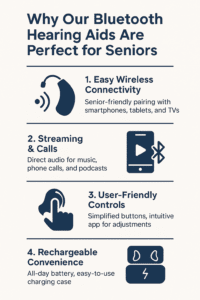As the global population ages, hearing loss is becoming increasingly common among seniors. With the rise of smart health solutions, Bluetooth hearing aids are now at the forefront of innovation, offering elderly users enhanced connectivity, better sound quality, and more control over their listening environments. But not all Bluetooth hearing aids are created equal. For project procurement managers sourcing reliable hearing care products, it’s essential to understand what sets our solutions apart.
Understanding the Needs of Senior Hearing Aid Users
Senior users have specific needs when it comes to hearing aids, including:
- Comfort: Lightweight and ergonomic devices that don’t cause ear fatigue
- Ease of use: Intuitive controls and simple app interfaces
- Sound clarity: Enhanced speech recognition, especially in noisy environments
- Battery life: Long-lasting power to avoid frequent recharging
- Discreet design: CIC and RIC models that blend seamlessly
What Makes Our Bluetooth Hearing Aids Ideal for the Elderly
We design our Bluetooth hearing aids with seniors in mind, balancing high performance with practicality. Here’s what makes our products stand out:
1. Seamless Bluetooth Connectivity
Our hearing aids connect effortlessly with smartphones, TVs, and tablets. Elderly users can answer calls, stream music, and adjust volume levels directly through their mobile devices, eliminating the need to fiddle with tiny buttons or manual dials.
2. Intelligent Noise Reduction Technology
Using advanced DSP chips, our hearing aids filter background noise and amplify speech in real time—crucial for seniors who struggle in group conversations or crowded places. This feature is essential for maintaining social engagement and cognitive health.
3. Rechargeable Battery with Extended Life
Our models support Type-C charging or charging cases that last up to 30 hours per cycle, reducing the need for seniors to replace small batteries or worry about power running out during outings.
4. One-Touch Control and App Support
Whether through physical buttons or app-based interfaces, we provide large, senior-friendly controls with clear labeling and visual feedback. Some models also support remote fitting and hearing test features via app.
5. Comfortable and Discreet Fit
From BTE to ultra-mini CIC designs, our hearing aids are built to be worn for long durations without irritation. Seniors appreciate the nearly invisible design, especially in social settings.
Comparison: Bluetooth Hearing Aids vs. Traditional Models
| Feature | Bluetooth Hearing Aids | Traditional Hearing Aids |
|---|---|---|
| Mobile Phone Streaming | ✅ Yes | ❌ No |
| App Control | ✅ Yes | ❌ Manual Only |
| Rechargeable Battery | ✅ Available | ❌ Disposable Only |
| Speech Clarity | ✅ Enhanced by DSP | ✅ Basic |
Why Procurement Managers Trust Us
- ISO 13485 & GMP certified facility
- FDA & CE-approved product lines
- 14+ years of hearing aid manufacturing experience
- OEM & ODM service with custom branding
- Low MOQ and stable monthly capacity of 100,000 units
Use Cases: How Bluetooth Hearing Aids Help Seniors Daily
- Phone calls: Hands-free conversations via Bluetooth
- Watching TV: Clear sound streamed directly to ears
- Outdoor walks: Wind noise suppression
- Doctor consultations: Easy volume adjustment during visits
- Remote family support: Some models allow app support by family members

Conclusion: Smarter Hearing for a Healthier Senior Life
Our Bluetooth hearing aids aren’t just devices—they are tools that empower elderly individuals to stay connected, independent, and socially engaged. For procurement professionals, sourcing from a proven manufacturer means ensuring reliability, usability, and satisfaction in every order.
📩 Want to try a sample or request a quote?
Contact our Bluetooth hearing aid experts today to explore your options.




